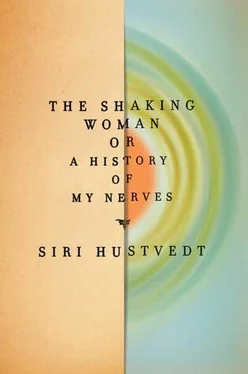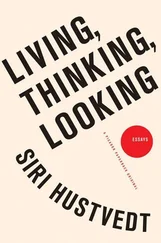On the day in question, I was one of four speakers. A well-known, popular novelist who had appeared on The Oprah Winfrey Show went immediately before me. He spoke movingly about his work with female prison inmates. His talk was sad, but it had a happy ending. Despite grotesque manipulations on the part of prison authorities to squelch the writing of the women he had taught, his efforts had triumphed in the end. People jumped to their feet. The applause was loud and long. Now it was my turn to offer up my adventures in the fields of the mind, including my work teaching writing to psychiatric patients in the hospital. I wasn’t at all nervous, although I knew that in comparison to the speech that had come before me, mine might seem arcane. My sincerity, however, was beyond question, and I felt good about what I had to say. I walked up to the stage, and the moment I uttered the first word, it happened again. I was shaking in front of hundreds of people. I gripped the podium, but my arms, torso, and legs were shuddering so badly that there was no disguising it. I had managed to push through the first paragraph when I heard someone in a front row say, “She’s shaking” and then another person, “I think she’s having a seizure.” Pressing my hands hard onto the sides of the wooden podium in front of me as the mortifying spasms continued, I told the audience to bear with me, that I was actually going to discuss the shaking a little later in the talk. Again my voice was unaffected, although I spoke too fast, hoping I could catapult myself to the end, which, I was convinced, would also bring the shaking to a halt. My husband (who had not attended the tree ceremony) told me later that he had never witnessed anything like it. Although I had described my earlier fit to him, he hadn’t understood how dramatic it had been. He was tempted to rush up onto the stage, grab me, and carry me bodily down the stairs.
But as I talked on, the shuddering began to diminish; not all at once but slowly, gradually my convulsive motion subsided. By the end of the talk, it had left me altogether. The audience was kind. They clapped. A neurologist, a psychiatrist, and a psychotherapist approached me afterward and, to my immense relief, offered not their services but reflections on the content of the speech. Several other people came up to me and told me I was “brave.” I didn’t feel brave. What was I to do? I hadn’t thought I needed an ambulance. I had been confident that the shaking would end when the speech did. The only options were to go on talking or to fall to the floor and admit defeat. A friend, who had been a professor of mine at Columbia University when I was a graduate student and who was also a participant in the seminar, told me afterward that it had been like watching a doctor and a patient in the same body. Indeed, I had been two people that day — a reasonable orator and a woman in the middle of a personal quake. Entirely against my will, I had demonstrated the very pathology I was describing.
For many hours afterward, I felt wobbly and exhausted. My limbs had a flulike soreness, and I was plagued by some dizziness. But above all, what I felt was fear. What if it kept happening? I asked myself whether the fits had been triggered by talking about my father or perhaps simply by anticipating that I was going to talk about him. But then why hadn’t I shaken at the Narrative Medicine lecture? Why had I felt so calm before the two episodes? Had the reception given to the popular novelist created a subliminal idea that after his victorious narrative my comments would be disappointing? Had I stayed up too late the night before and drunk too many cups of coffee that morning? I had sat through a lecture on panic attacks given by a pharmacologist in which he had made it clear that vulnerability can be created by certain behaviors. Smokers, for example, are more prone to panic than nonsmokers. I had stopped smoking years before, but caffeine is a stimulant that might have predisposed me to the shakes. Disappointingly, my self-diagnosis of conversion disorder had not resolved my problem. Another lecture was looming. I had been asked to speak on another topic altogether at the Prado Museum in Madrid, as part of a series of talks on the old masters and modernism. The paper had been written, the PowerPoint presentation prepared. Maybe I’d go to pieces again. Maybe every time from now on I’d shake when I stood up in public. I needed help, and not from some figment of my imagination. I called a psychiatrist friend, someone I could trust to recommend a smart and serious professional. In an e-mail, he suggested that rather than hysteria, I had a version of panic disorder. What I needed was some medicine to get me through an hour at the Prado. Later, I could deal with the deeper issues that might be causing me to shake. He referred me to a pharmacologist.
Finally, I told my story to Dr. F., a real psychiatrist in a real office. He turned out to be attentive and sympathetic. He listened patiently as I described my migraine history, what I contended was a single seizure, my friend’s suggestion that I had some form of panic disorder, and my own theory that I might be a conversion case. He told me frankly that my fits didn’t correspond to panic disorder because I wasn’t worried in advance; I had never felt I was endangered in any way, and I knew I wasn’t dying. He sent me off with a prescription for six 0.5-milligram tablets of lorazepam, and a referral to an epilepsy specialist. Before I delivered my presentation in Madrid, I took the pill. I didn’t shake. I made an appointment with the epilepsy specialist but canceled it.
My journey, both imagined and real, had led me in a circle, and what caused my fits was still unknown. Lorazepam probably calmed me down enough to inhibit the shaking at the Prado. It and other benzodiazepines are used to treat genuine epileptic seizures as well as panic attacks, so the effectiveness of the drug couldn’t help a physician make a diagnosis in my case. On the other hand, the talk I gave had nothing to do with my father, which might have spared me the shakes in all events. And to complicate things further, a placebo might have worked just as well. It’s now known that simply believing that a pill will help you can release opioids in your brain that make you feel better; or, as the authors of one study put it; “cognitive factors (e.g., expectations of pain relief) are capable of modulating physical and emotional states.” 25 Ideas, it seems, are powerful and can alter us. As Janet pointed out, the carriage wheel doesn’t have to drive over your leg; having the idea can be enough to paralyze the limb. Was it simply the idea of my father’s death that made me shake? Or was it something else? The only certainty was that it wasn’t available to my consciousness; I am not able to put it into words. The idea is hidden somewhere else. The question is, Is it possible to find it?
SOMETIMES THEORIES PRECEDE the technology that will prove them right, and sometimes technology races ahead of theory. The latter is true of the advances that have changed neuroscience research. PET (positron emission tomography), SPECT (single photon emission computed tomography), and fMRI (functional magnetic resonance imaging) scans have all been used to examine people’s brains, as well as other organs of the body. The colored pictures that many people have seen in magazines and on television indicate blood flow to various regions of the brain. The theory is that the more oxygenated the blood flow, the more brain activity. What the pictures actually show and how to read them remains controversial, however. Time and again I have heard scientists articulate their doubts about what the images actually mean, and yet the pictures are often called upon as evidence, are fascinating to look at, and are useful tools despite the fact that they cannot be considered the be-all and end-all of scientific research. But when brain scans enter the popular press, they are mostly cleansed of the doubt that surrounds them. On September 26, 2006, the Science section of the New York Times published an article entitled “Is Hysteria Real? Brain Images Say Yes.” Aside from the fact that this headline makes one wonder what is meant by the word real, it offers insight into misconceptions about mental illness and the mind-body relation. The unarticulated argument is that if a hysterical paralysis or seizure shows up on a brain scan, an illness once thought to be “all in your head” is actually in your body, and if it’s in your body, its “reality” is confirmed. “Hysteria seemed to be a vanished 19th-century extravagance,” the journalist writes, “useful for literary analysis but surely out of place in the serious reaches of contemporary science.” Again, a hierarchy is established. Those pesky people who take literature seriously may have some use for hysteria, but why would scientists, the masters of culture who determine our truths, be concerned with something so retrograde as hysteria? “The word itself seems murky,” she continues, “more than a little misogynistic and all too indebted to the now unfashionable Freud.” 26The journalist is right that hysteria has negative connotations for women and that even people who have never read a word of Sigmund Freud feel free to condemn his theories because his ideas, like the illness of hysteria, have fallen out of fashion. But as valuable as they may be, brain scans can’t explain conversion.
Читать дальше












